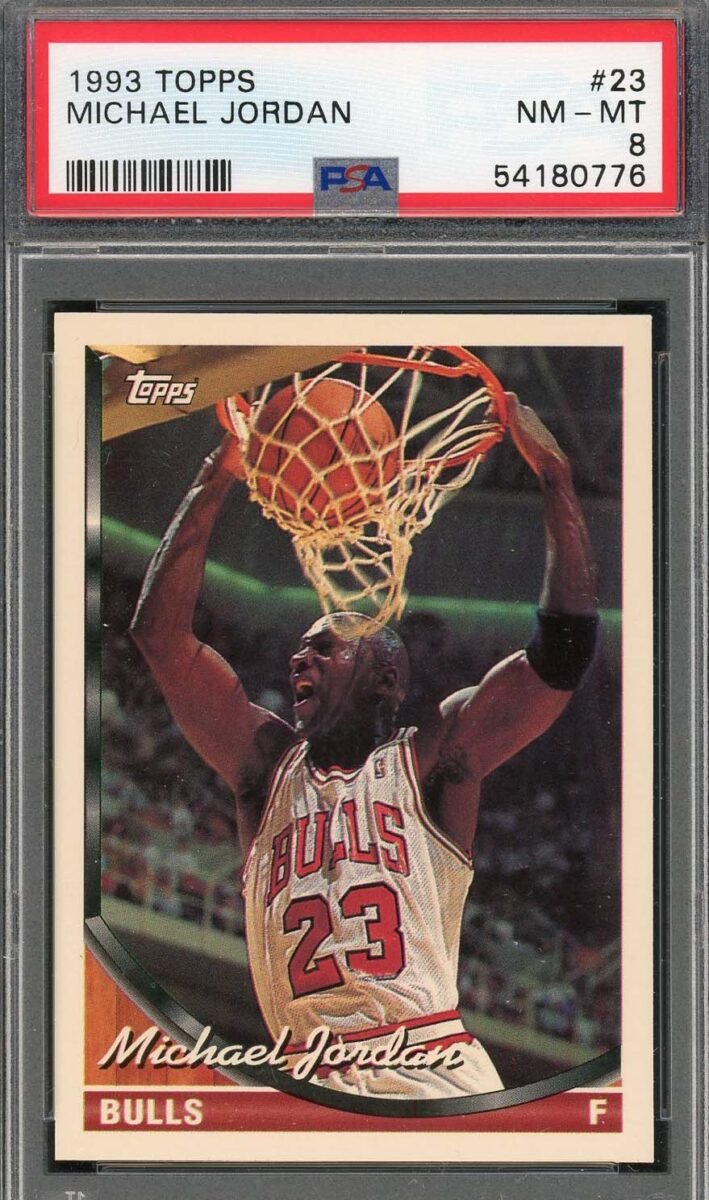Introduction to Card Grading
Card grading is a systematic method employed to evaluate the condition of sports cards, including Topps basketball cards, which play a significant role in the collectibles market. Essentially, grading assesses various aspects of a card, including centering, corners, edges, and surface quality. It provides a score that conveys a card’s overall condition, thereby influencing its market value significantly.
Professional grading services, such as PSA (Professional Sports Authenticator) and BGS (Beckett Grading Services), standardize this evaluation process. These organizations utilize a detailed scale, typically ranging from 1 to 10, where 10 indicates a flawless card. This grading is crucial for collectors and investors alike, as the condition often dictates how much a card is worth in the marketplace. A well-graded card can command significantly higher prices compared to its poorly graded counterparts, making grading an essential aspect of the collecting experience.
Topps basketball cards have garnered immense popularity since their inception. These cards not only connect enthusiasts to basketball culture but also represent integral pieces of the sports memorabilia landscape. As collectors seek to enhance their collections, understanding the grading process becomes vital. High-quality graded Topps basketball cards can not only serve as personal possessions but also as strategic investments, given their potential to appreciate in value over time. Consequently, knowing how grading impacts card prices is of paramount importance for anyone engaged in the hobby.
Understanding Topps Basketball Cards
Topps basketball cards have garnered significant attention among collectors since their inception in the late 1950s. Established as one of the pioneering forces in trading cards, Topps has produced numerous series that showcase players across different eras. The company initially focused on baseball cards but expanded into basketball in 1957, introducing cards that featured rising stars and legendary players. Over the decades, Topps has created various series, including the famous Chrome series, which is known for its shiny, reflective finish and has raised the standard for card quality in the industry.
The appeal of Topps basketball cards lies not only in the quality of production but also in the athletes they depict. Historically significant players like Michael Jordan, Larry Bird, and Kobe Bryant have been featured in Topps sets, making these cards especially desirable among collectors. Certain cards are considered valuable due to their rarity, condition, and the hallmarks of emergent talent they exhibit. For instance, rookie cards of popular players often fetch high prices due to demand among enthusiasts who seek to own a piece of basketball history. The condition of these cards is paramount; those graded by professional grading services often command higher prices, influencing the overall market value.
In recent years, the popularity of Topps basketball cards has surged, driven by factors such as the resurgence of interest in nostalgia amongst older collectors and the influx of new enthusiasts discovering basketball’s rich history. The trading card community has witnessed remarkable trends, including the rise of digital marketplaces and social media platforms, which have made it easier for collectors to buy, sell, and trade their cards. As such, understanding the history and appeal of Topps basketball cards not only enhances one’s appreciation for the cards themselves but also offers a glimpse into the broader dynamics of sports memorabilia collecting.
The Grading Scale Explained
Understanding the grading scale is essential for collectors and investors in the Topps basketball card market. Professional grading services, such as PSA (Professional Sports Authenticator) and BGS (Beckett Grading Services), evaluate cards based on a standardized scale that ranges from Poor (PR) to Gem Mint (GEM-MT). This scale plays a critical role in determining the card’s value and desirability among collectors.
The grading scale is typically categorized as follows:
- Poor (PR1): Cards in this condition are heavily worn, with significant creases, tears, or other forms of damage. They are often deemed almost uncollectible.
- <strongfair (fr1-2): These cards have noticeable wear but may retain some visual appeal. They often exhibit surface wear and slight corner rounding.
- Good (GD2-3): Good condition cards show damage but are more appealing than fair cards. They may have scuffs or slight bends but are still recognizable.
- Very Good (VG4-5): Cards graded as very good have fewer flaws, with minor imperfections like slight corner wear or scuffed surfaces.
- Excellent (EX6-7): Excellent cards display minor wear but are mostly intact, presenting well for collectors. Edges and corners remain strong.
- Near Mint (NM8): Near mint cards are particularly appealing, showing little to no wear. They appear fresh, with sharp corners and well-defined edges.
- Mint (MT9): Mint cards are nearly perfect, showcasing impressive centering and flawless surface quality.
- Gem Mint (GEM-MT10): The highest grade, gem mint cards exhibit no flaws visible to the naked eye. Achieving this rating is rare and indicates exceptional condition.
Factors contributing to a card’s grade include centering, corners, edges, and surface quality. Centering refers to how well the image is aligned on the card; imbalances can lower the grade significantly. Corners must be sharp and without bending to maintain a high value. Edges ought to be smooth and free of nicks or roughness. Finally, surface quality is evaluated for scratches, print defects, and discoloration. Each element is meticulously assessed by experts, ensuring that the grading is both reliable and informative for buyers and sellers in the Topps basketball card market.
How Grading Affects Value
In the world of collecting sports cards, particularly Topps basketball cards, grading plays a pivotal role in determining market value. The grading system, which assesses the condition of a card on a scale of 1 to 10, is fundamental to establishing a card’s desirability among collectors. Higher-graded cards, often rated 8 or above, tend to command significantly higher prices compared to their lower-graded counterparts. This premium placed on condition highlights the intrinsic value placed on rarity, preservation, and overall aesthetics in the hobby.
For example, a Topps basketball card graded PSA 10 can fetch thousands of dollars, whereas a card graded PSA 5 may only bring in a fraction of that price. This stark difference illustrates how essential card grading is in the marketplace. Several factors contribute to this dynamic, including the supply of high-grade cards versus the demand from collectors and investors. As collectors increasingly seek top-tier cards to complete their collections, the availability of well-preserved cards naturally diminishes, leading to greater price disparities.
The influence of grading also introduces a structured hierarchy within the trading card market. Collectors often prioritize graded cards for investment purposes, as they provide a more reliable assessment of a card’s quality. This prioritization fosters a competitive environment where higher-grade cards become coveted, driving up prices and creating opportunities for savvy investors. Thus, grading directly impacts the perceived value of Topps basketball cards, establishing a clear correlation between grade, market demand, and pricing dynamics. For those looking to navigate this marketplace, understanding grading can significantly enhance their collecting strategy and investment potential.
standards, especially for modern cards.
Services: Grading and authentication for Topps sports and non-sports cards, with subgrades for centering, corners, edges, and surface.
Website: https://www.beckett.com/grading
Process: Online submission or through authorized dealers. Grading scale from 1-10 with subgrades.
3. Certified Guaranty Company (CGC)
Expertise: Known for their expertise in both sports and non-sports cards, including Topps products.
Services: Grading, authentication, and encapsulation of Topps cards from various eras.
Website: https://www.cgccards.com/
Process: Online submission system with detailed grading scale and turnaround options.
4. Sportscard Guaranty Corporation (SGC)
Expertise: Specializes in vintage sports cards but also grades modern Topps cards.
Services: Grading and authentication services for Topps sports cards, with a focus on older issues.
Website: https://www.gosgc.com/
Process: Online submission with various service levels available.
Factors Affecting Topps Card Value
- Condition: The overall state of the card, including corners, edges, and surface quality.
- Rarity: Limited editions, short prints, and vintage cards often command higher prices.
- Player/Subject Popularity: Cards featuring star players or popular characters are typically more valuable.
- Year and Set: Certain years and sets are more desirable to collectors.
- Special Features: Autographs, game-used memorabilia, or unique printing variations can increase value.
- Market Demand: Current collector interest and market trends affect card values.
Tips for Topps Card Appraisal
- Research recent sales of similar cards to get a baseline value.
- Consider professional grading for high-value or vintage Topps cards.
- Use online resources like price guides and population reports to assess rarity.
- Be aware of the differences between sports and non-sports Topps cards in terms of valuation.
- Keep your cards properly stored to maintain their condition and value.
Remember, professional appraisal is crucial for understanding the true value of your Topps sports and non-sports collector game cards. Whether for insurance purposes, potential sale, or personal knowledge, these appraisal services can provide expert insights into your cherished collection.
Market Trends in Grading
In recent years, the market for graded Topps basketball cards has demonstrated significant growth and volatility, emphasizing the impact of grading on card values. Collectors and investors are increasingly recognizing the importance of condition, and graded cards have started commanding higher prices compared to their ungraded counterparts. Current data indicates that graded Topps basketball cards can sell for up to twice as much as cards that haven’t undergone the grading process. This disparity is not merely a reflection of condition but also of perceived authenticity and rarity, making graded cards more appealing to buyers.
The demand for grading services has fluctuated considerably. Following a surge in popularity for sports cards during the pandemic, grading companies faced unprecedented volumes of submissions, resulting in some delays and increased turnaround times. This influx of demand spurred more collectors to seek out graded cards, leading to an uptick in prices as the market sought a limited number of highly graded examples of popular players. However, as the market has stabilized, some fluctuations have been observed; certain cards that once peaked in value have seen declines as the grading market adjusts to the influx of new submissions and collectors reevaluate their holdings.
Collector behavior plays a pivotal role in these trends. Enthusiasts are now more educated about the grading process, leading to a preference for cards that are graded by reputable companies. As collectors become more discerning, there is a growing focus on acquiring cards that not only have high grades but also feature desirable characteristics, such as limited print runs or iconic player images. This evolving collector mindset fosters increased competition for top-tier graded cards, thereby sustaining their value and reinforcing the grading trend as a key determinant of market prices.
The Benefits of Grading for Collectors
Grading has become a crucial aspect of the sports card market, particularly for serious collectors of Topps basketball cards. One of the primary benefits of grading cards is the significant increase in resale value that graded cards often experience. Cards classified with high grades by reputable grading companies tend to command higher prices than their ungraded counterparts. This price differential provides collectors with an understandable incentive to invest in the grading process, as it can lead to substantial returns, particularly when selling cards from coveted collections or vintage sets.
Another key benefit of grading is the protection of valuable assets. Collectors often invest considerable sums of money into their card collections, making it essential to ensure that these assets are adequately safeguarded. Grading companies typically encapsulate cards in tamper-proof holders, preventing damage from handling and environmental factors such as humidity or light exposure. This protective measure not only preserves the current condition of the card but also maintains its grade over time, which is vital for long-term investments.
Beyond financial aspects, the peace of mind associated with professional evaluation cannot be overstated. For collectors, knowing that a card’s value has been verified by experts provides reassurance when navigating the often volatile card market. This validation also aids collectors in organizing and prioritizing their collections, allowing for informed decision-making when adding to or selling from their inventory. Furthermore, for those who may eventually consider auctioning their cards, having a professional grade enhances the credibility of the item being sold, attracting more serious bidders.
Overall, grading serves not just as a tool for valuation and protection but also as a marking of quality that resonates with both collectors and investors alike. As the demand for graded Topps basketball cards continues to rise, understanding the benefits of grading becomes paramount for anyone serious about their collection.
Risks and Considerations
While grading can significantly enhance the value of Topps basketball cards, it is not without its inherent risks and considerations that collectors must carefully evaluate. One of the primary concerns is the associated costs of the grading process. Collectors should be aware that submitting cards for grading often incurs fees ranging from a modest amount to a substantial sum, depending on the card’s value and the grading service employed. These expenses can eat into potential profits, particularly if the graded card does not achieve the anticipated high grade.
Another critical factor is the risk of overpaying for already graded cards. The market can sometimes inflate prices on cards that are graded by well-known services, leading collectors to assume that a high grade translates to a commensurate monetary value. However, it is essential to conduct thorough research on comparable sales of the same card in various grades. Graded cards that command premium prices may not always guarantee a sound investment, especially if the collective demand diminishes or if there is market volatility.
Moreover, the grading system has its limitations that need consideration. Grading is a subjective process based on the standards of the grading organization, and different companies may allocate grades differently. A card received a Gem Mint 10 from one service might only be deemed a Mint 9 from another. Therefore, it is advisable to familiarize oneself with the grading criteria and the reputation of the grading company before purchasing graded cards.
Ultimately, navigating these challenges requires diligent research and informed decision-making. Collectors are encouraged to weigh the risks against the potential benefits of grading. By acquiring knowledge about grading methodologies and maintaining a critical eye on market trends, collectors can make prudent choices that align with their investment goals in the Topps basketball card market.
Future of Grading and the Card Market
The ongoing evolution of grading in the sports card market is poised to reshape the landscape for collectors, investors, and the overall value of Topps basketball cards. Innovations in technology, such as artificial intelligence and advanced imaging techniques, are expected to streamline the grading process, allowing for quicker and more consistent evaluations of card quality. These advancements may reduce subjective bias, fostering greater trust in graded cards among collectors. As technology continues to progress, one can foresee a rise in automated grading systems that provide reliable assessments without human intervention.
Additionally, the introduction of blockchain technology in grading could enhance transparency and traceability of card history, ensuring that the provenance of each card is easily verifiable. Such developments may help curtail fraudulent activities that plague both the grading market and the card market in general. As collectors become more educated about these advancements, their behavior may shift towards favoring cards with enhanced verification measures, ultimately affecting demand for Topps basketball cards.
Collector behavior is also likely to shift as younger generations enter the market, influenced by digital platforms and social media. This demographic shift could lead to increased interest in unique or scarce Topps basketball cards, as collectors seek items that reflect both personal and cultural significance. Moreover, the introduction of grading tiers or specialty labels for rare or unique cards could create new segments in the market, impacting pricing strategies.
In conclusion, the future of grading and its implications on the card market holds significant potential for transforming how Topps basketball cards are valued and traded. As technology advances, the effects on pricing mechanisms and collector behavior will be pivotal in shaping the future landscape of the trading card industry.
Conclusion
In the ever-evolving landscape of card collecting and investment, grading has emerged as a cornerstone that significantly influences the prices of Topps basketball cards. The grading process, which evaluates the condition and authenticity of cards, can dramatically affect their market value. Collectors and investors alike must recognize that a higher grade often correlates with a greater demand and, consequently, a higher price point. Graded cards not only provide assurance of quality but also serve as a benchmark for market trends within the trading card industry.
Understanding the nuances of card grading is essential for enthusiasts who aim to navigate this complex market effectively. Knowledge of grading standards can empower collectors to make informed purchasing decisions, ensuring they invest wisely in their collections. Higher-graded Topps basketball cards can become significant assets, holding not just sentimental value but also great potential for future appreciation. This is particularly evident during fluctuations in the market, when the rarity and condition of a card can drastically alter its desirability.
Moreover, the increasing popularity of graded cards among collectors highlights their role as reliable commodities within the broader trading card market. This trend underscores the importance of recognizing how the grading process shapes not only personal collections but also the strategies of serious investors. As more collectors begin to comprehend the various grading systems and how they impact card prices, they will be better equipped to approach their collecting passions with a strategic mindset.
In summary, the grading of Topps basketball cards plays an invaluable role in determining their market value and desirability. Whether for enjoyment or investment purposes, understanding grading is critical for anyone looking to engage successfully in the trading card market.


